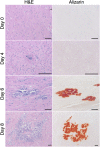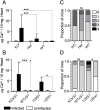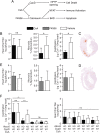Cyclosporine A Treatment Inhibits Abcc6-Dependent Cardiac Necrosis and Calcification following Coxsackievirus B3 Infection in Mice
- PMID: 26375467
- PMCID: PMC4574283
- DOI: 10.1371/journal.pone.0138222
Cyclosporine A Treatment Inhibits Abcc6-Dependent Cardiac Necrosis and Calcification following Coxsackievirus B3 Infection in Mice
Abstract
Coxsackievirus type B3 (CVB3) is a cardiotropic enterovirus. Infection causes cardiomyocyte necrosis and myocardial inflammation. The damaged tissue that results is replaced with fibrotic or calcified tissue, which can lead to permanently altered cardiac function. The extent of pathogenesis among individuals exposed to CVB3 is dictated by a combination of host genetics, viral virulence, and the environment. Here, we aimed to identify genes that modulate cardiopathology following CVB3 infection. 129S1 mice infected with CVB3 developed increased cardiac pathology compared to 129X1 substrain mice despite no difference in viral burden. Linkage analysis identified a major locus on chromosome 7 (LOD: 8.307, P<0.0001) that controlled the severity of cardiac calcification and necrosis following infection. Sub-phenotyping and genetic complementation assays identified Abcc6 as the underlying gene. Microarray expression profiling identified genotype-dependent regulation of genes associated with mitochondria. Electron microscopy examination showed elevated deposition of hydroxyapatite-like material in the mitochondrial matrices of infected Abcc6 knockout (Abcc6-/-) mice but not in wildtype littermates. Cyclosporine A (CsA) inhibits mitochondrial permeability transition pore opening by inhibiting cyclophilin D (CypD). Treatment of Abcc6 -/- mice with CsA reduced cardiac necrosis and calcification by more than half. Furthermore, CsA had no effect on the CVB3-induced phenotype of doubly deficient CypD-/-Abcc6-/- mice. Altogether, our work demonstrates that mutations in Abcc6 render mice more susceptible to cardiac calcification following CVB3 infection. Moreover, we implicate CypD in the control of cardiac necrosis and calcification in Abcc6-deficient mice, whereby CypD inhibition is required for cardioprotection.
Conflict of interest statement
Figures









Similar articles
-
Early Treatment of Coxsackievirus B3-Infected Animals With Soluble Coxsackievirus-Adenovirus Receptor Inhibits Development of Chronic Coxsackievirus B3 Cardiomyopathy.Circ Heart Fail. 2019 Nov;12(11):e005250. doi: 10.1161/CIRCHEARTFAILURE.119.005250. Epub 2019 Nov 13. Circ Heart Fail. 2019. PMID: 31718319
-
Inhibition of Histone Deacetylase Activity Aggravates Coxsackievirus B3-Induced Myocarditis by Promoting Viral Replication and Myocardial Apoptosis.J Virol. 2015 Oct;89(20):10512-23. doi: 10.1128/JVI.01028-15. Epub 2015 Aug 12. J Virol. 2015. PMID: 26269170 Free PMC article.
-
Treatment of coxsackievirus-B3-infected BALB/c mice with the soluble coxsackie adenovirus receptor CAR4/7 aggravates cardiac injury.J Mol Med (Berl). 2006 Oct;84(10):842-51. doi: 10.1007/s00109-006-0076-y. Epub 2006 Aug 5. J Mol Med (Berl). 2006. PMID: 16924471
-
A Kidnapping Story: How Coxsackievirus B3 and Its Host Cell Interact.Cell Physiol Biochem. 2019;53(1):121-140. doi: 10.33594/000000125. Cell Physiol Biochem. 2019. PMID: 31230428 Review.
-
Natural Products as a Paradigm for the Treatment of Coxsackievirus - induced Myocarditis.Curr Top Med Chem. 2020;20(8):607-616. doi: 10.2174/1568026620666200129094516. Curr Top Med Chem. 2020. PMID: 31995007 Review.
Cited by
-
Drug Repositioning for Hand, Foot, and Mouth Disease.Viruses. 2022 Dec 27;15(1):75. doi: 10.3390/v15010075. Viruses. 2022. PMID: 36680115 Free PMC article. Review.
-
Mitochondrial damage activates the NLRP10 inflammasome.Nat Immunol. 2023 Apr;24(4):595-603. doi: 10.1038/s41590-023-01451-y. Epub 2023 Mar 20. Nat Immunol. 2023. PMID: 36941400
-
Clinical and molecular characterization of COVID-19 hospitalized patients.PLoS One. 2020 Nov 18;15(11):e0242534. doi: 10.1371/journal.pone.0242534. eCollection 2020. PLoS One. 2020. PMID: 33206719 Free PMC article.
-
Mt10 Vaccine Protects Diversity Outbred Mice from CVB3 Infection by Producing Virus-Specific Neutralizing Antibodies and Diverse Antibody Isotypes.Vaccines (Basel). 2024 Mar 4;12(3):266. doi: 10.3390/vaccines12030266. Vaccines (Basel). 2024. PMID: 38543901 Free PMC article.
-
Guidelines for evaluating myocardial cell death.Am J Physiol Heart Circ Physiol. 2019 Nov 1;317(5):H891-H922. doi: 10.1152/ajpheart.00259.2019. Epub 2019 Aug 16. Am J Physiol Heart Circ Physiol. 2019. PMID: 31418596 Free PMC article. Review.
References
-
- World Health Organization. Global atlas on cardiovascular disease prevention and control. 2011.
-
- McCaffrey FM, Braden DS, Strong WB. Sudden cardiac death in young athletes. A review. Am J Dis Child. 1991;145(2):177–83. Epub 1991/02/01. . - PubMed
Publication types
MeSH terms
Substances
Grants and funding
LinkOut - more resources
Full Text Sources
Other Literature Sources
Molecular Biology Databases

